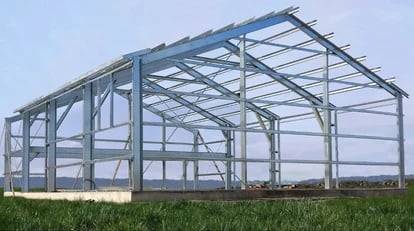Cold-formed metal framing, or cold-formed steel framing, is a construction technique that utilizes various steel framing members to create the building structure.
 As the construction industry constantly strives for sustainable, durable, and versatile materials, cold-formed metal has emerged as a leading choice in modern building techniques. Its significance goes beyond mere functionality; it signifies a transformation in construction, blending traditional principles with contemporary needs.
As the construction industry constantly strives for sustainable, durable, and versatile materials, cold-formed metal has emerged as a leading choice in modern building techniques. Its significance goes beyond mere functionality; it signifies a transformation in construction, blending traditional principles with contemporary needs.
Cold-formed metal framing utilizes roll-forming technology to shape metallic-covered coils into various components. Some common finished parts include studs, joists, tracks, headers, angles, and truss members. As the name implies, cold-formed parts do not require the use of heat during the production process. In contrast, heat is a crucial element during the production of hot-rolled steel parts, like an I-beam.
Steel is available in an array of thicknesses, which allows it to flex for use in both structural and non-structural applications. According to ACT Building Systems, a cold-formed building is constructed using cold-formed steel cee sections that are securely fastened together to create the foundation of the structure. This includes various components such as portal frames, columns, and rafters.
History of Cold-Formed Metal Framing
The story of cold-formed metal framing can be traced back to the late 19th century, but it gained momentum after World War II, when nations were busy rebuilding.
The following decades saw its popularity skyrocket, thanks to advancements in technology, manufacturing processes, and a growing recognition of its benefits.
Cold-formed metal framing proved cost-effective during economic recessions and adaptable to various construction scenarios, which further propelled its adoption.
Advantages of Cold-Formed Metal Framing
Unlike materials such as wood, which is vulnerable to pests, or hot-rolled steel, characterized by its weight and reduced versatility, cold-formed metal presents an optimal blend of resilience and adaptability.
Cold-formed buildings offer owners many obvious benefits when compared to other building construction methods:
- High weight-to-strength ratio - despite being lightweight, it offers structural strength akin to much heavier materials.
- Cold-formed metal is resistant to pests, fire, decay, and even earthquakes.
- This material's longevity is notable, with many structures lasting decades with minimal maintenance.
- Its malleability allows it to be shaped into virtually any form, providing unparalleled design flexibility.
- Cold-formed metal framing stands out for its sustainability - it is recyclable, reducing its carbon footprint.
- It offers faster construction times and fewer labor-intensive processes than traditional building methods.
- Cold-formed buildings require minimal maintenance
Challenges and Considerations
As with any building construction, it's imperative to install the cold-formed components as directed by the manufacturer or project-specific engineered stamped plans. Failure to follow these recommendations can lead to structural integrity issues. While the initial costs of certain materials or techniques may appear higher, it is important to consider the long-term expenses in light of the durability and reduced maintenance requirements that cold-formed metal framing offers.
Furthermore, metals naturally expand and contract in response to changes in temperature. While it's imperative to consider the issue, most experienced manufacturers and designers are well-versed on the topic and follow simple approaches to address the issue of thermal contraction and expansion.
Future of Cold-Formed Metal Roof and Building Framing
In terms of cost, there might be an inclination to view cold-formed steel as a more expensive choice; however, its long-term advantages often make the investment worthwhile. As global building standards continue to evolve, it's expected that cold-formed metal framing as a construction method will continue to gain even more prominence.
Moreover, the rise of smart buildings presents new opportunities for seamlessly integrating cold-formed metal framing, ensuring not only structural integrity but also optimizing energy efficiency and promoting sustainability.
Cold-formed metal roof and building framing provide an innovative solution to the challenges faced in modern construction. Its multitude of advantages makes it an enticing choice for architects, builders, and investors to consider for future projects.
About McElroy Metal
Since 1963, McElroy Metal has served the construction industry with quality products and excellent customer service. The employee-owned components manufacturer is headquartered in Bossier City, La., and has 14 manufacturing facilities across the United States. Quality, service and performance have been the cornerstone of McElroy Metal’s business philosophy and have contributed to the success of the company through the years. As a preferred service provider, these values will continue to be at the forefront of McElroy Metal’s model along with a strong focus on the customer.






.png?width=440&height=293&name=How%20to%20Install%20Metal%20Roofing%20Over%20Existing%20Metal%20Roofs%20(1).png)


Comments on this article:
Scroll down to the bottom to submit a comment and join the conversation. Need help or have a question? Please contact us. Looking for a distributor or contractor? Please click here to get started.